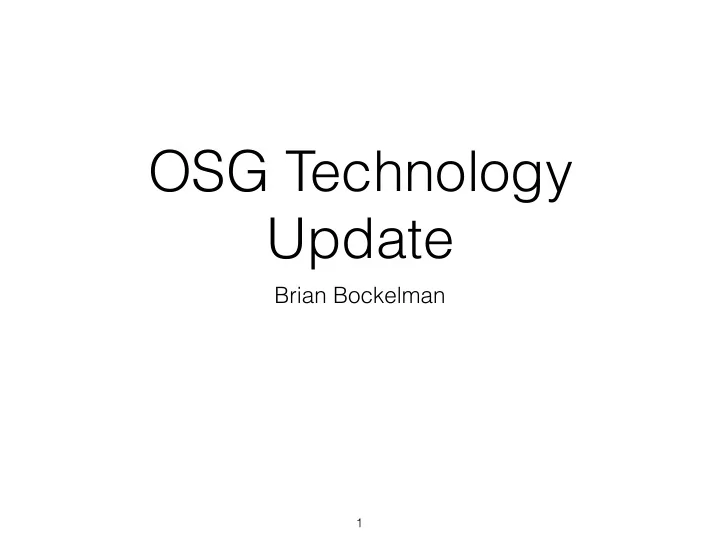

OSG Technology Update Brian Bockelman 1
State of the Union • OSG Technology has drastically evolved over the past five years: • CE philosophy transition from “job submission” to “resource acquisition” (pilots). • Underlying CE technology transition changed from Globus GRAM to HTCondor-CE. • Information services are transitioning from LDAP to HTCondor-based. • Accounting system is being modernized. • VO-installed software (when needed) migrated to OASIS . • Storage stack is being simplified. • The Technology Area additionally collaborates closely with operations for OSG’s expanded portfolio of services. 2
Storage Simplification • SRM retirement : • Goal to retire SRM endpoints from one USATLAS and one USCMS site this year. One USCMS site done ; actively partnering with USATLAS. • Remove bestman2 from release series (April 2017?). Would imply dropped support by fall 2017. • Stash / StashCache : Responding to the fact that storage management / storage element paradigm is too complex for the non-LHC VOs, • Stash : Effort by User Support team to provide a single high-performance storage element for OSG VO users. • StashCache : Effort by OSG Technology to provide a caching layer for any VO, tuned for working set sizes O(10TB). • The single-SE / caching paradigm requires far less investment from VOs to utilize. 3
OASIS / OSG-Storage • OASIS is the name for our CVMFS infrastructure: • HTTP-based content distribution network for repository contents. • Single, shared repository at GOC. Good for VOs with little / no support and OSG-internal activities. • Key-signing infrastructure for VO-hosted repositories. Good for VOs with active support teams (such as FIFE). • OASIS provides an install-once, read-almost-everywhere semantics for VO software, when needed . To maximize portability, users & VOs are encouraged to use simpler techniques (HTCondor file transfer) where applicable. • OSG Storage is a new extension for OASIS. Allows VOs utilizing StashCache to provide a POSIX interface to StashCache. 4
HTCondor • HTCondor now provides the base for our information system, CE, OSG VO- hosted service, and glideinWMS service. • Having a common base software stack allows us to concentrate our expertise and minimize our dependencies on external teams. • To some extent, there’s a never-ending treadmill of needed scalability improvements and, for the CE, improvements of the batch system integration. • This is mostly delivered by the HTCondor Flightworthy team. • OSG’s leadership in this area is reflected in increased partnerships with the European HTCondor community. • CERN is steadily migrating from LSF / CREAM to HTCondor / HTCondor-CE. This means LHC VOs must maintain a high level of compatible with these shared components! 5
GRÅCC • Our accounting system, Gratia, has been on minimal-maintenance-only for several years. The central Gratia collector has reached a breaking point. • We are integrating a new service, GRÅCC (pronounced “grok”), that reuses many standard components that are currently Gratia code: • RabbitMQ for message distribution. • ElasticSearch for the backend database. • LogStash for uploading records to the database. • Grafana / Kibana for analytics and visualization. • On top of these three components, we have various integration scripts to transform & replay this data. It’s being run as a new service, not a software product. • Importantly, this allows us to re-route records to alternate backends (such as XDMod). Goal is to have each piece of functionality be pluggable: never again replace all at once! • Status : Basic functionality has been demonstrated. Between here and September, plan is to flesh out more functionality and integrate with various accounting scripts (e.g., uploading to WLCG). Goal is to have the option of turning off Gratia by December 31, 2016. 6
Future-looking Projects • Improved isolation of payloads. Investigating use of singularity , a software project from LBL, to provide the same level of isolation as glexec without x509 certificates . • On future platforms (RHEL8), this can be done in completely unprivileged mode. Isolation could be done across the OSG with no site support necessary ! • Modernize the authentication / authorization infrastructure. The software (GUMS, edg-mkgridmap, VOMS-Admin) and processes (authz/authn template generation) are nearly obsolete. • No current activities beyond planning. I don’t expect any software we use today for auth{z,n} to be used in 5 years . 7
The Next Five Years • The next five years hold many challenges: • Finish off the many ongoing transitions! • Improve integration with non-OSG resources: HPC facilities, non-WLCG sites, commercial clouds. • Slowly expand our storage capabilities from the current OSG-Storage offerings. Particularly, we need an external software partner if we want revolutionary work here. • Increasingly decouple our user authentication & authorization scheme from the “traditional grid model”. 8
Recommend
More recommend